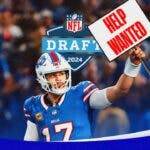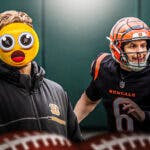This year's quarterback class boasts three players who could be taken in the first five picks, and at least one other first-round prospect. There are also some intriguing options later on with a myriad of different skillsets, strengths, and weaknesses. Here are the top five QBs in the 2020 NFL Draft.
5. Jalen Hurts, Oklahoma
The last two first overall picks have been QBs from Oklahoma. And while the streak will end this year, Hurts increased his stock by leaps and bounds during his one season in Norman.
He was a finalist for the Heisman Trophy after throwing for over 3,800 yards with 32 touchdowns and eight interceptions. He also added nearly 1,300 yards on the ground to go along with 20 rushing scores. Hurts is an excellent runner, is mobile in the pocket, and is very accurate on short and medium throws.
He doesn't take many chances, but also lacks the processing speed and anticipation of a top prospect. It will be interesting to see how Hurts fares in a more pro-style offense when his supporting talent is not significantly better than the opposition. He is likely to be a Day 2 pick, and will probably get a year to sit behind a veteran and develop. Without a strong arm, it's difficult to project Hurts' ceiling at the next level, but his skillset fits the direction that some teams are moving towards.
4. Jordan Love, Utah State
Love is your classic boom or bust prospect. He will make plays that are reminiscent of Patrick Mahomes, but he will buffer those with far too many terrible decisions and errant passes on routine plays. In 2018, he threw 32 TDs and six picks. But last season those numbers plummeted to 20 scores and 17 INTs.
Love has all the physical talent in the world, but he is wildly inconsistent, mechanically underdeveloped, and he does not read defenses well. His regression from his sophomore to junior seasons isn't encouraging either. But Love's potential is off the charts, and teams with an established veteran starter will be looking closely at Love as someone they can mold into a star. The risk is great, but the reward is perhaps even greater.
3. Justin Herbert, Oregon
Following his sophomore year, Herbert looked like a future first overall pick. In eight games he threw for nearly 2,000 yards to go along with 15 TDs and five picks. As a junior and senior, his numbers improved (61 touchdowns to 14 INTs in total), but his actual play did not. Herbert never developed like he was expected to, and faltered in his biggest games. His 6-foot-6, 236-pound frame, good running ability, and cannon arm will get him drafted highly (perhaps fifth overall to the Miami Dolphins). But his performance has not matched his traits.
Oregon's offense (both with scheme and surrounding talent) did him no favors, and he seems like a smart person and hard worker. Improving his accuracy and focusing on the mental aspect of the game will be vital for Herbert's development. And while he could start right away and not be a complete disaster, it would be better if he had time to sit and learn behind a veteran, like Miami's Ryan Fitzpatrick.
2. Tua Tagovailoa, Alabama
If it weren't for Tagovailoa's significant injury concerns, there would be plenty of intrigue about which QB the Bengals will take on Thursday night. For two years — and one legendary College Football Playoff Championship Game comeback — Tua was one of the most prolific passers in the game. Over his career, he threw for nearly 7,500 yards, 87 touchdowns, and only 11 interceptions. He is athletic within the pocket and can make throws on the run. He is extremely accurate and has enough arm strength to make any throw. He sees the field well and faces blitzes confidently. On the field, he's everything you want in a franchise QB.
The problem is he carries a significant injury risk. He only missed five games during his career, but his injury history is very concerning. He played through nearly all of his issues, but he was constantly dealing with them, and doesn't take hits well at all. He hasn't learned how to protect himself. Here is Tua's injury rap sheet:
- Broken finger
- Sprained knee
- Quad injury
- Left high ankle sprain
- Right high ankle sprain
- Dislocated right hip with posterior acetabular wall fracture
According to reports, Tagovailoa's hip injury appears to be healing well. And he recently tweeted out a video of him running through practice drills in order to replace Alabama's cancelled Pro Day. But it's entirely fair to label him as an injury-prone player. If he can stay healthy, he'll be an excellent NFL QB. But that's a big if. Regardless, he's expected to be the second QB off the board, which is a testament to just how good of a player he is.
1. Joe Burrow, LSU
At Ohio State, Burrow redshirted his freshman year in 2015. He played in just 10 games over the next two seasons as J.T. Barrett's backup. In 2017, Burrow suffered a string of injuries. And when fellow backup Dwayne Haskins entered the team's regular season finale against Michigan and played well, Burrow knew his time in Columbus was drawing to a close.
Having graduated in three years with a degree in consumer and family financial services, Burrow still had two years of eligibility remaining, and would qualify as a graduate transfer. That means he could play immediately for a new school. He chose LSU, and started 13 games, throwing for nearly 2,900 yards, 16 scores, and five picks. Pedestrian numbers, but Burrow improved as the season went on as he missed out on most of LSU's offseason program. The team's archaic offensive scheme also did him no favors.
In 2019, with Joe Brady at offensive coordinator, everything changed for Burrow. He went from an afterthought to a Heisman winner and National Champion. He led the Tigers to a 15-0 record with one of the greatest QB performances in college football history. He completed 76% of his passes for nearly 5,700 yards, 60 touchdowns, and only six interceptions. He played in a dynamic system and with elite supporting talent, but what Burrow did was nothing short of spectacular.
He has good size at 6-foot-3, 221 pounds. He has a good, but not great arm. He is mobile and his pocket presence is pristine, better than that of many NFL vets. He reads the field very well, has great anticipation, and is fantastically accurate. It's difficult to find any major flaw in his game. The closest things to weaknesses would be his arm (which is strong enough to make any throw, but isn't a howitzer), and the fact that he does only have one year of elite play.
But his play in 2019 was unprecedented to the point where he should have no trouble adjusting to the NFL game. Burrow is worthy of the first overall pick in every way.




